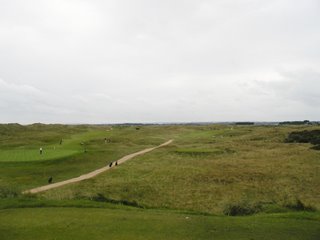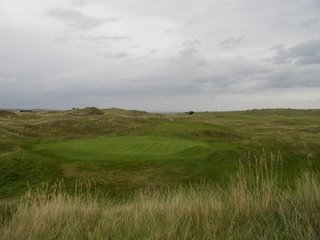
The 3rd at Deal
The following principles come from the book called “Concerning Golf” by John Low. I thought it might be fun to look at each and see how well they hold up after so much time has passed and how much the game has changed.
1. A golf course should provide entertainment for the high and medium handicapper while at the same time present a searching and difficult test for the accomplished golfer.
I don’t think there is an architect alive who doesn’t wish there course to have the same impact, some courses have achieved this lofty goal like Pinehurst #2, but most miss the mark.
2. The one aim of inventors is to reduce the skill required for golf. Golf architects must wage a battle against inventors by designing courses that emphasize golfing skills over equipment.
This is one of the more interesting ones since the inventor has definitely overpowered the architect to a point where we can no longer battle; and some of our greatest courses are in jeopardy. The biggest change from his era to ours is the value of land and the economics of the game have changed; we simply can’t afford the additional land. Would he feel it is up to us [the architects] to battle still, or would he be frustrated with the wide gulf between good players and the average player.
3. The shortest, most direct line to the hole, even if it be the centre of the fairway, should be fraught with danger.
This reminds me of Max Behr’s idea of the line of charm and the line of instinct. Alister Mackenzie also echoed this exact premise by suggesting the best bunkers are often in the place we would like to play to. That it is up to the golf architect to break up the straight line with hazards that force a player to negotiate as close a they dare to gain an advantage. I wonder if this influenced Mackenzie
4. The architect must allow the ground to dictate play. The good architect sees that there is a special interest for the accomplished golfer in each stroke, just as the billiard player always has in mind the next stroke or strokes.
This can be taken many ways, but each is a principle close to my heart. The ground contains the best and most interesting contours and should dictate play including the green surfaces themselves. The ground [or land] also contains features that make for natural hazards that are best used to make the game interesting to play. Finally this could mean leaving all the unusual stances and lies that come with a natural course. This is similar to the principles echoed by people like Bill Coore.
5. The fairway must be orientated to both the tee and the green, thereby stressing the importance of placing the tee shot in a position from which the green can be approached with safety.
This simply brings up the idea of playing for position and being rewarded for getting a ball to a desired location. Whether this means the typical risk and reward strategy employed by most architects or the flirt and reward idea of a Mike Strantz; he clearly is a believer in the strategic school of design [as am I].

The 6th at St. Enodoc
6. Bunkers should be used sparingly by the architect. Except on one-shot holes, they should never be placed within 200 yards of the tee. Ridges and depressions are the best way of controlling an entrance to the green. The best hazard on a course is a fairway bunker 200 to 235 yards from the tee, placed five to ten yards off the accomplished player's most favourable line to the green.
This is where I begin to depart. I have never believe in a standardization of bunker placement since it tends to only add interest and challenge to the one class of player. Substitute 200 for 250 yards and you see what I mean about this being a one dimensional answer that does not even consider effect of the wind. I do like the idea of less bunkers and more use of natural ridges and rises though.
7. Wherever possible, putting greens should be of the low, narrow plateau type, with the plateau tilting away, not toward the player. No green should be higher at the back than it is in front, for that gives a player confidence. Only half the flagstick should be seen from where the approach shot should be played.
Again, I find this general rule to restrictive. I’m fascinated by what he say about a back to front green providing confidence. The idea of all greens falling away from play would be equally as boring as all greens sloped to play. The green he describes is also very difficult to hit and very demanding; I’m really not sure how a high handicap player would deal with this [see first rule].
8. A course should never pretend to be, nor is it intended to be, an infallible tribunal of skill alone. The element of chance is the very essence of the game, part of the fun of the game.
We once again agree; the idea of luck, a bad bounce, or the fortuitist break is essential in the true spirit of the game. That’s why I get so upset when it all gets removed by over grading and over-shaping.
9. All really great golf holes involve a contest of wits and risks. No one should attempt to copy a great hole because so much may depend on its surroundings as well as some features miles away in the background which influence and affect the play of the hole. If the terrain is suitable, some of the character of the original might be incorporated elsewhere.
I’m mixed on this idea, on one side I agree with good architects “find” the holes that nature provides to get the most out of a site; but I do believe that we should draw on the really great ideas for inspiration too. I have always believed that there are no really any new ideas, and that architects should be nimble with their own adaptations of proven principles to make the best holes. I think we should borrow from great holes, like the Redan, make our own allowances and adaptations for the land.
10. Inequalities of putting green surfaces should not be exaggerated. A tilt from front to back, or left to right or vice versa is sufficient. There should always be a special position for the flag on important days.
Completely disagree with this one. Greens offer so many options and so many unique strategies through contour, land form, or even architectural features. Walter Travis courses would not be near as interesting without the funky contours that force us to plan our approach or use our imagination to solve the putts. I certainly find courses with simple greens to be far less inspiring than ones that require additional thought once you reach a surface [or even before].
I think his ideas are very strong, but they certainly do not completely reflect mine; I left them in there entirety so you can judge them for yourself. I think it is important to review writers like John Low or Alister Mackenzie [who also wrote his own principles] to give us a base to find our own principles.
If I ever get enough nerve, I may try write my own principles and present them on the forum.




















































